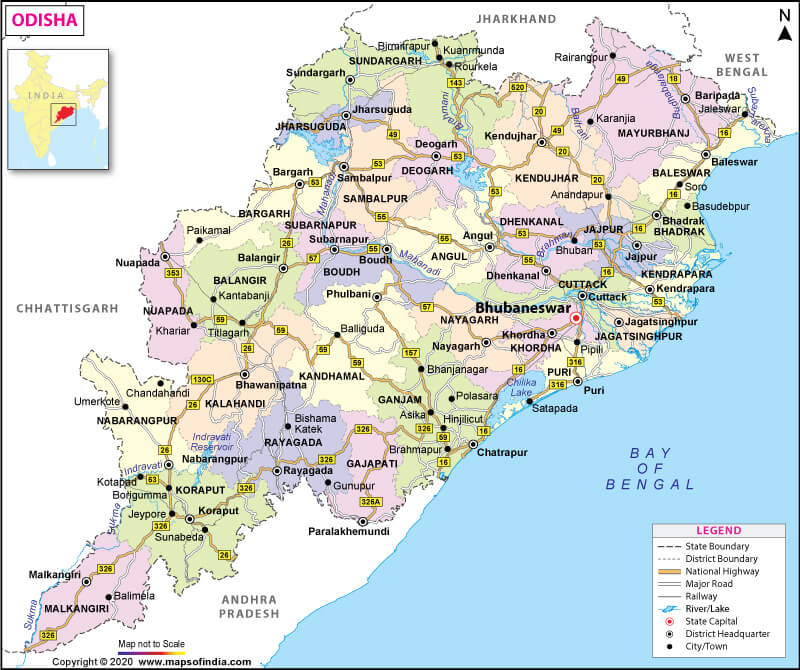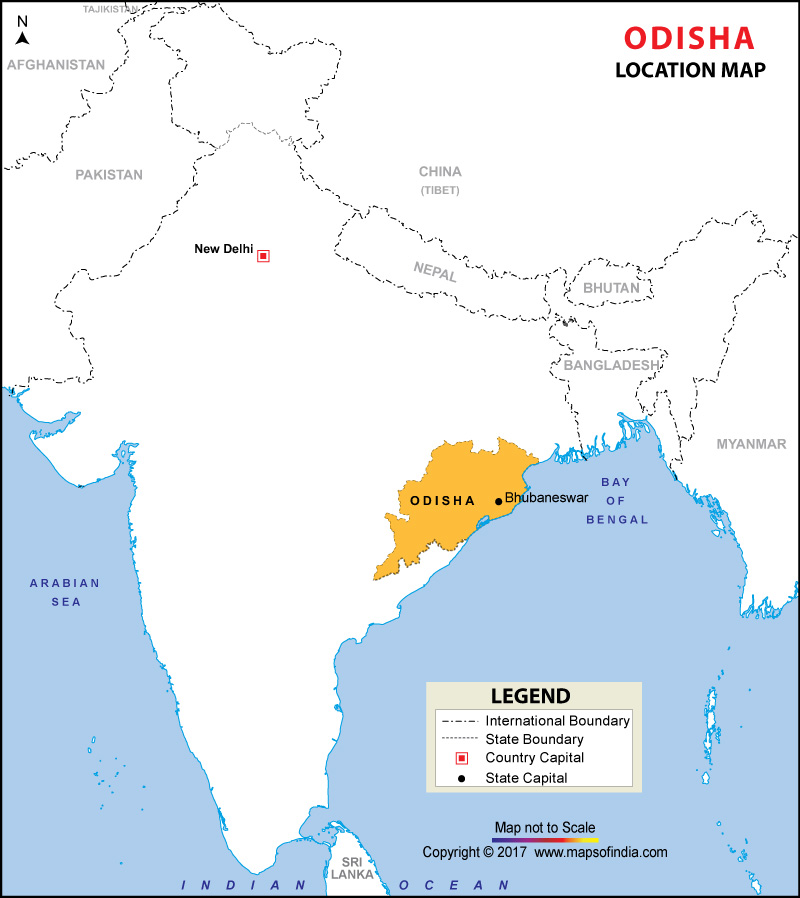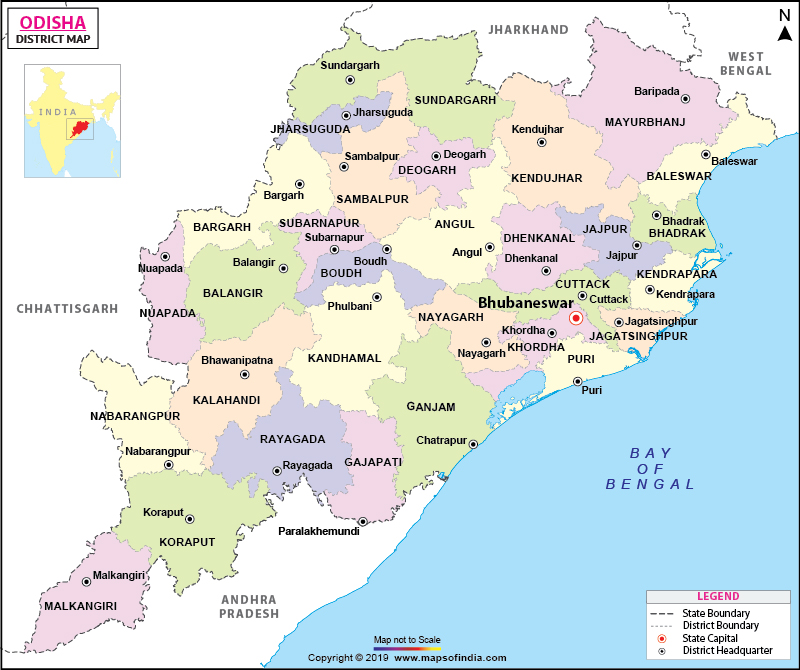

Where is Odisha?
Odisha, formerly known as Orissa, is a northeastern state of the country. Before India became independent, Odisha’s capital was Cuttack. Afterward, the present-day capital was built at Bhubaneshwar in the east-central coastal plains. After the Rajya Sabha passed the Alteration of Name Bill and adopted the Constitution (113th) Amendment Bill in the year 2011, Orrisa became Odisha, and the language changed from Oriya to Odia. The state has the 11th largest population of Scheduled Tribes in India, with a population of 41,974,218 as per the 2011 census. The British Indian government demarcated the modern-day boundaries here, and the ‘Province of Orissa’ was set up on April 1, 1936.
What is the Geography of Odisha?
Considered to be the 8th largest state by area, Odisha spreads over 155,707 square km (60,119 square miles) and a coastline of 450 km. Jharkhand and West Bengal adjoin Odisha to the north and northeast, Bay of Bengal to the east, Andhra Pradesh and Telangana to the south and Chhattisgarh to the west. The state predominantly divides into four natural divisions: northern plateau, eastern ghats, central tract, and coastal plains. The main rivers in the states are Mahanadi, Subarnalekha, Budhabalanga, Baitarani, Brahmani, Rushikulya, and Vamsadhara. Odisha is home to one of the largest lagoons in India, namely Chilka Lake (saltwater lake). Three-quarters of the state is enveloped in mountains. Some of the significant mountain peaks are Mahendra Giri 4,924 feet, Malayagiri 3,894 feet, and Megasini 3,822 feet.
With an alloy of several physiographic features in Odisha, the state divides into five morphological units which are:
- Mountainous and Highlands Region
- Coastal Plains
- Western Rolling Uplands
- Central Plateaus
- Flood Plains
What is the Climate of Odisha?
Odisha, situated in the tropical savanna, also known as tropical wet-dry and it divides into six traditional seasons, namely Grisma (summer), Barsha (rainy season), Sharat (autumn), Hemanta (dewy), Sheeta (winter), and Basanta (spring). Further, the state also undergoes four meteorological seasons: winter (January-February), pre-monsoon (March-May), southwest monsoon (June-September), and northeast monsoon (October-December).
The state experiences the coldest temperatures in January. May is the warmest where the mercury ranges from mid 30° C to 20° C. Odisha receives an average annual rainfall of 60 inches (1,500 mm), which mostly occurs during the months of the southwest monsoon (June through September).
The forest cover around one-third of Odisha and are of two types; tropical moist deciduous that occupies the hills, plateaus in the northeastern part, and tropical dry deciduous in the southwest. Besides, the thickness of forest cover generally declines from northeast to southwest. Tropical hardwoods and Bamboo grow in both forests.
Preservation of a wide range of wildlife happens in parks and sanctuaries established by the state and national governments. Some of the mammals in there are elephants, gaurs, blackbucks, four-horned antelope, types of tigers, and species of peacocks. Chilka Lake, in the east-central coastal region, is breeding various kinds of fish.
What is the Economy of Odisha?
In Odisha, about three-fifths of the working population is involved in agriculture. Though, the state can produce only a single annual crop fruitfully like rice because the land is mostly unproductive and arid. Other agro-products include legumes, cereals such as wheat, corn, oilseeds, vegetables, sorghum, jute, sugarcane, coconuts, and spices. Factors that contribute to the low production of the state’s farmers are sparse use of fertilizers, low sunlight availability, scanty soil quality, and sorghum, to name some. As farming does not provide the required income, farmers often supplement their income through non-agricultural pursuits. The state leads in the production of chromite, bauxite, manganese ore, graphite, and nickel ore.
Some of the major manufacturing industries here are chemicals, ceramic products, aeronautics equipment, cement, ferromanganese, alumina, etc. Handicraft is a small sector in the state, yet it is one of the significant ones.
The service sector contributes a significant portion of the economy here, such as banking and finance, insurance, trade, hotel, etc.
What is the Transportation of Odisha?
At the beginning of the mid – 20th century, defined construction programs were undertaken by the government, like – the building of bridges over most of its principal rivers. National highways and major railways were constructed in the 21st century.
Odisha is home to many railways situated in Bhubaneshwar, Puri, Baleshwar, Cuttack, Khurda Road, Brahmapur. Some of the major airports are Biju Patnaik International Airport, Savitri Jindal Airport, Brahmapur Airport, to name a few.
What are the Tourist Attractions of Odisha?
Some of the tourist attractions are Puri, Bhubaneshwar, Konark, Cuttack, Baripada, Gopalpur, Chandipur, Sambalpur, Talasari Beach, Rourkela, Tikarpada Wildlife Sanctuary, Hirakud Dam, Simipal National Park, Daringbadi to name a few.
Related Maps:



